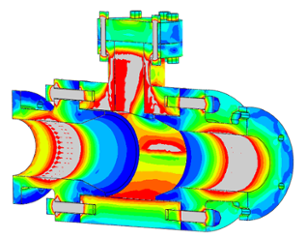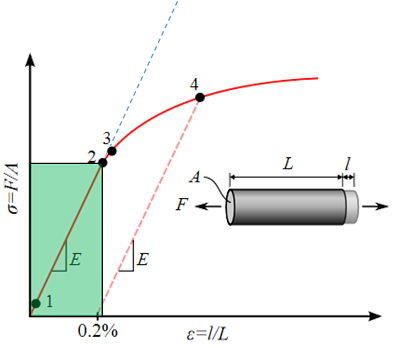This article focuses on Finite Element Analysis for plastic or metal valves in the higher pressure range within the Valve industry, and how plastic deformation in the valve housings can be estimated on a more efficient way. Both Simuleon B.V. and our joint venture partner: Strategic Simulation & Analysis Limited from UK, have participated in projects for the Oil & Gas industry, in this case: High Pressure Valves.
When pumps and valves operate in high pressure ranges, you need to ensure that they are robust enough and don’t cause issues during operation. How to prove that a design will potential work within the specifications is unfortunately less obvious. Of course you can and most likely will use the ASME VIII as a guideline, but decoding, understanding and applying what ASME VIII says is unfortunately far from trivial.
Just prevent yield to occur?
If a high pressure valve is at its operating pressure, or at is maximum pressure for testing purposes, the body of the valve will have small areas that already show stress results beyond the yield limit. So just taking the traditional approach to perform linear analysis and make sure that the components are kept out of the region of yield limits, simply doesn’t work. These small regions that show stress values above yield limits generally don’t cause component failure, but how do you prove that?
How do you prove that the high stress areas aren’t problematic?
We see a lot of companies who judge this based on experience, but of course as a Simulation Engineer, you should model this behaviour to get a true understanding of what actually happens in the valve.
Stress Linearization as a traditional approach
In the valve industry as well as for pressure vessels, it is quite common to perform Stress Linearization. Stress linearization is a technique which was developed to allow an assessment of the yielding in a structure, and judge whether this yielding leads to premature component failure. The issue with Stress Linearization is that it is essentially a judgement call based on codes and checks, and requires some degree of creativity in its application. It doesn’t model what actually happens in the failure process; which a proper elasto-plastic analysis would. In all fairness, stress linearization as an approach dates from a time when a decent linear model of a valve would have been quite an achievement.
Elasto-Plastic approach allowed by ASME
Luckily it turns out that ASME does allow in its codes, the use of an elasto-plastic approach in the assessment of valve bodies, especially in extreme applications. And this has some real advantages; and not just in terms of compliance. By modelling the actual plasticity developing in the solid body you have a picture of what is really happening. And if the growth of the plastic zone is moderate, and doesn’t run away out of control at test pressures, you have a real assessment of the design’s response; which you can use to both show compliance, and understand where you are on the spectrum which ranges from test failure to commercial success.
To show compliance in the simulation process, the solution needs to converge at the test pressure. The point at which the solution becomes unstable is the point at which plasticity has spread through the wall (dangerous). And for that reason compliance is based on the solver converging. This means that you should be working with a solver which doesn’t have convergence issues before the test pressure point is reached. Something like Abaqus for example.
Our experience with the Elasto-Plastic approach
We have done quite some projects for which, because of our current NDA’s, we are not allowed to talk about it. Therefore we have put together an example model which has all the features of a typical high pressure valve. We have modelled all the contact interfaces, applied 3D solid bolt representations, in order to be able to show how the yielded material is explicitly modelled, rather than having its influence inferred.
So how do you ensure safety during plastic deformation in high pressure valves?
As a Simulation Engineer, please feel tempted to try the Elasto-Plastic approach as an alternative to the Stress Linearization approach. We think that this is a good alternative and more accurate way of modelling what actually happens in the valve, for values that are close to, or beyond the yield limits. The elasto-plastic approach also tends to be less conservative than the Stress Linearization approach, and therefore could create possibilities to generate more performance bandwidth in your actual design without simply adding more costly material. Of course you will be in a need of more material specifications, which for the typical high grade steels is probably easier to get that the equivalents for plastic materials.





